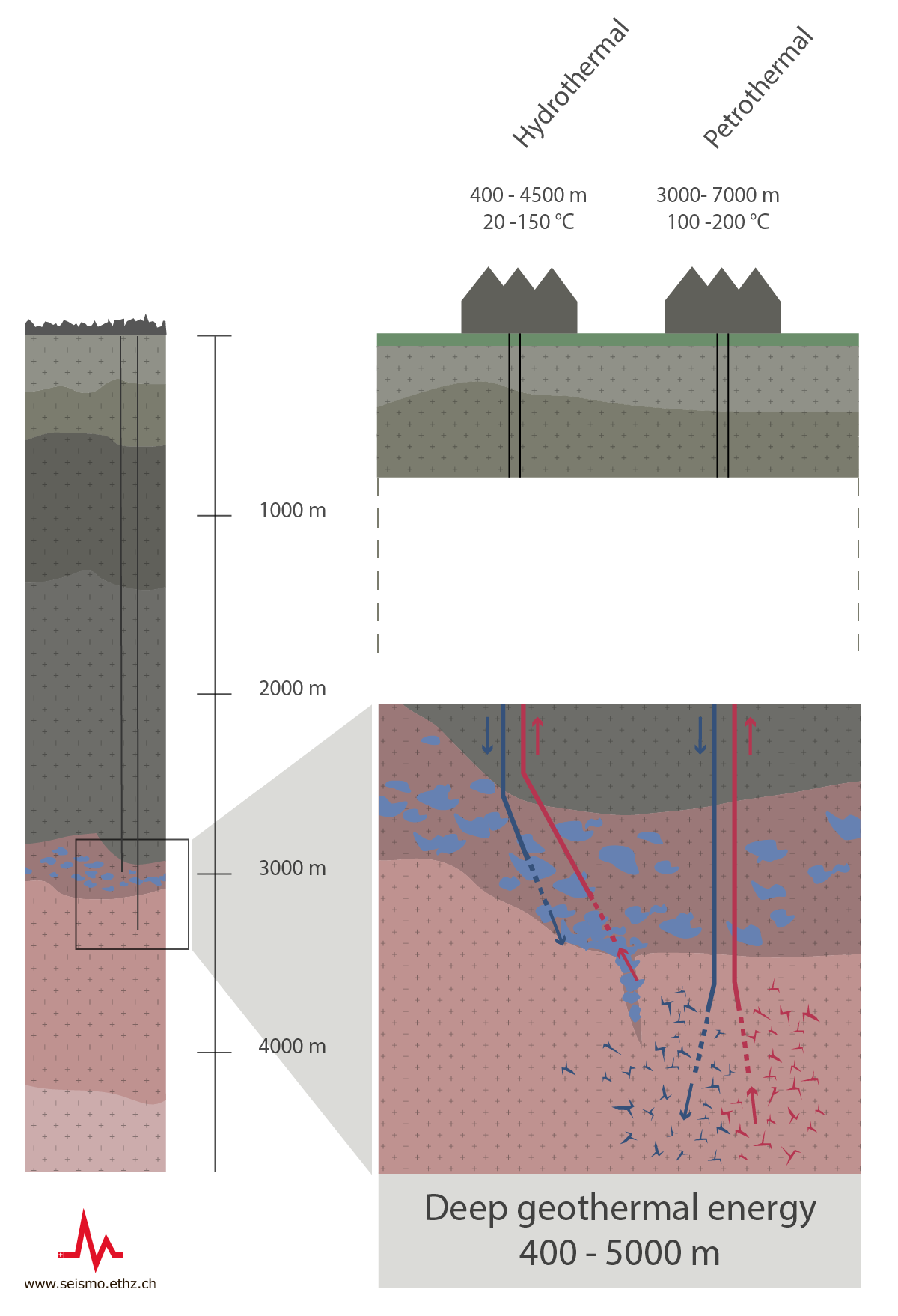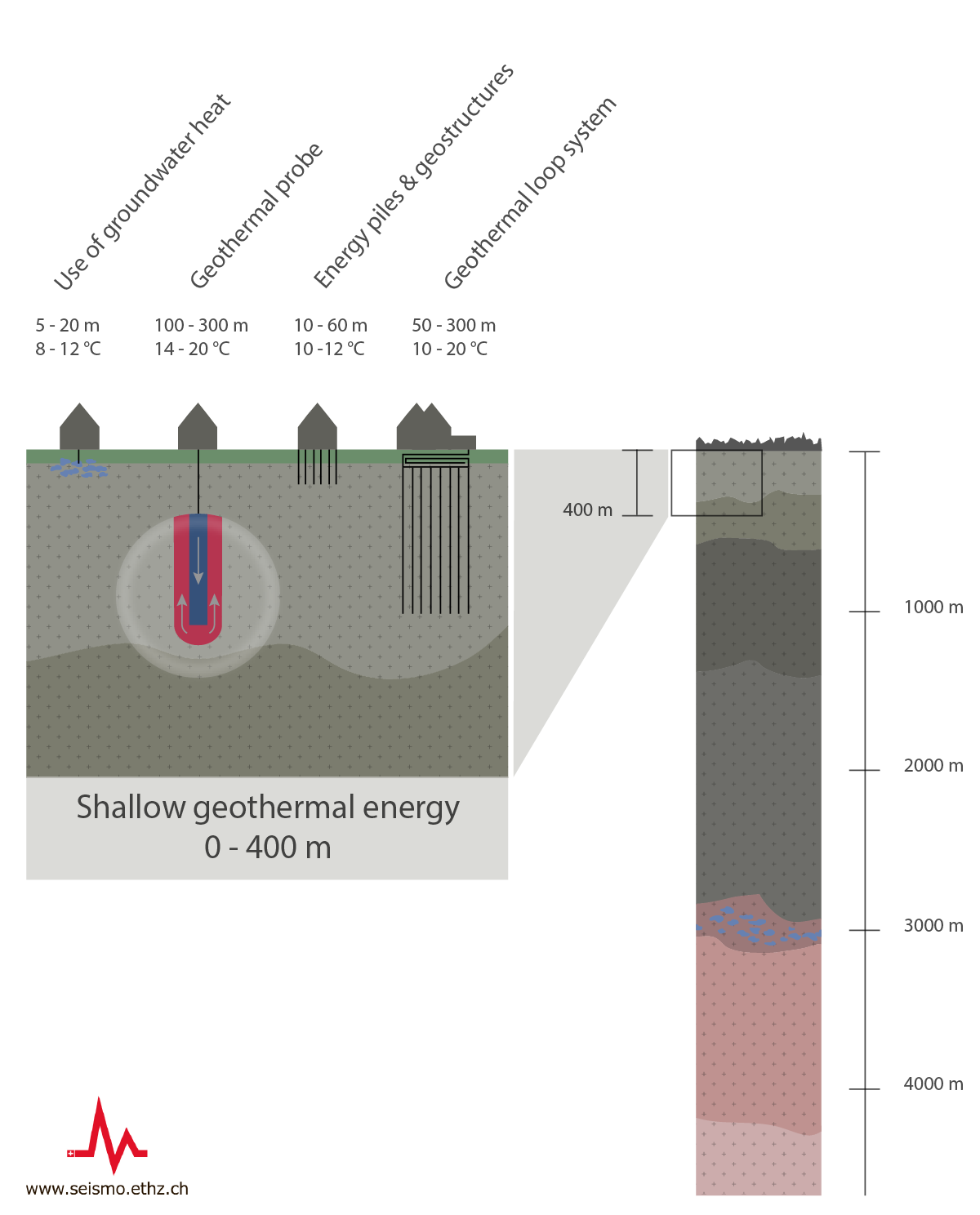Forms of Geothermal Energy
A distinction is made between two forms of geothermal energy, depending on the depth and the heat used: deep geothermal energy and shallow geothermal energy (up to approximately 400 meters). The Swiss Seismological Service (SED) focuses exclusively on deep geothermal energy because, according to current understanding, it is the only form that can lead to induced earthquakes. Other types of intervention that can trigger induced earthquakes in the subsoil can be found here.
The following explanations aim to briefly clarify the central terms surrounding the topic of geothermal energy and have been compiled from a range of referenced sources.
Deep Geothermal Energy
Deep geothermal energy accesses rock structures at least 400 meters into the earth, and various uses are possible depending on the temperatures in the subsoil.
Temperatures of between 20°C and 70°C are found in aquifers (layers of rock or soil that can absorb and hold water) at depths of 400 to 2,000 meters. The thermal water found at these depths is suitable not only for bathing but also for heat production, and systems that exploit the drainage water from tunnels can be put to a similar use (SFOE, Nutzung der Erdwärme - Überblick, Technologie, Visionen).
At depths of 4,000 meters, temperatures beneath Switzerland are between 150°C and 200°C. Geothermal energy projects that access these layers of rock generally use part of the energy recovered directly for power production, while the rest can be fed into a district heating grid.
A distinction is made between two systems for energy recovery at great depth: petrothermal and hydrothermal.
In petrothermal systems, tens of thousands of cubic meters of liquid (1 m3 = 1,000 liters) – generally water – are injected over several days into the subsoil under high pressure, typically into the crystalline basement rocks. The aim here is to reactivate the many fault systems in the future reservoir. The permeability of the rock is permanently increased for water circulation by means of microearthquakes of varying intensity, giving rise to an enhanced geothermal system (EGS). This system serves as an underground reservoir in which liquid circulates and is heated. The microearthquakes associated with the process are closely monitored. This is done with a view to both ensuring optimum control of induced seismicity (see Measures to Control Induced Seismicity) and drawing conclusions about the condition and extent of the constantly growing reservoir. An artificial circuit is then created via a second borehole to pump heated liquid to the surface with the aid of geothermal energy. The liquid circulates in an only partially closed circuit, with the reservoir pressure and the flow being controlled by balanced feed and production rates.
The procedure to increase permeability – known as stimulation – triggers a series of ever smaller earthquakes. In this regard, the earthquakes are not an undesired side effect but a tool for manipulating the subsoil. The large majority of these earthquakes are so small that they are not noticeable to the public. The art of stimulation lies in creating a fault system in such a way that the greatest possible volume can flow through evenly without creating a “shortcut”, which can occur when water flows too quickly from one borehole to another before being heated sufficiently. At the same time, it is essential to avoid large earthquakes, which cause damage. The question of how best to achieve this balancing act is being studied extensively by scientists and industry representatives worldwide. Background information on this topic can be found in the Roadmap for Deep Geothermal Energy from the Swiss Competence Center for Energy Research – Supply of Electricity (SCCER-SoE).
The petrothermal system, formerly also referred to as the “hot dry rock” process or “deep heat mining”, has been applied in Basel for example. Petrothermal systems can, in principle, be implemented throughout Switzerland. In order to be economically attractive, a commercial petrothermal system should provide approximately 50 to 200 liters of water per second with a temperature of 150°C to 180°C. In addition, the water temperature should fall only slowly during the operating period of around 30 years.
In principle, hydrothermal systems use existing aquifers in sediments in order to pump the hot water that occurs there naturally to the surface. Profitable electricity generation requires aquifers with hot water with a temperature of 100°C or more (hot springs generally do not reach these temperatures. Following extraction of the heat, the cooled water is sometimes pumped back into the subsoil via a second borehole. Provided there is sufficient water flow at depth, only minimal stimulation of the rock is generally necessary, with the result that microearthquakes do not necessarily occur as a consequence, unlike with petrothermal systems.
The Geothermal Energy Project in St. Gallen was based on the hydrothermal system. Hydrothermal systems depend on existing aquifers with adequate fissuring and sufficiently high temperatures, which is why they can only be implemented at certain locations. Extensive seismic investigation is therefore often a prerequisite for identifying a suitable location.
Shallow Geothermal Energy
Shallow geothermal energy includes geothermal probes or geothermal loop systems and use of groundwater heat, as well as energy piles and geostructures. Shallow geothermal energy penetrates no more than 400 meters into the subsoil (BMU Brochure "Tiefe Geothermie - Nutzungsmöglichkeiten in Deutschland"") and makes use of layers with temperatures of between 8°C and 20°C (SFOE Brochure "Nutzung der Erdwärme").
Geothermal probes are most frequently used to operate heat pumps that obtain heat from the earth, air, or water. Shallow geothermal energy with geothermal probes can be used to heat buildings and prepare hot water, whereby pumps of this kind additionally require electricity. A heat pump is based on the principle of a reverse refrigerator, also needing a supply of energy (a more detailed description can be found on the website of the Fachvereinigung für Wärmepumpen Schweiz [Swiss heat pump association]. Provided a depth of around 200 meters is not exceeded, geothermal probes can also be used to cool buildings in summer (St. Galler Stadtwerke "Ökologische Energie aus der Tiefe").
Induced earthquakes are not an issue in shallow geothermal energy due to the shallow depth and generally closed systems.

